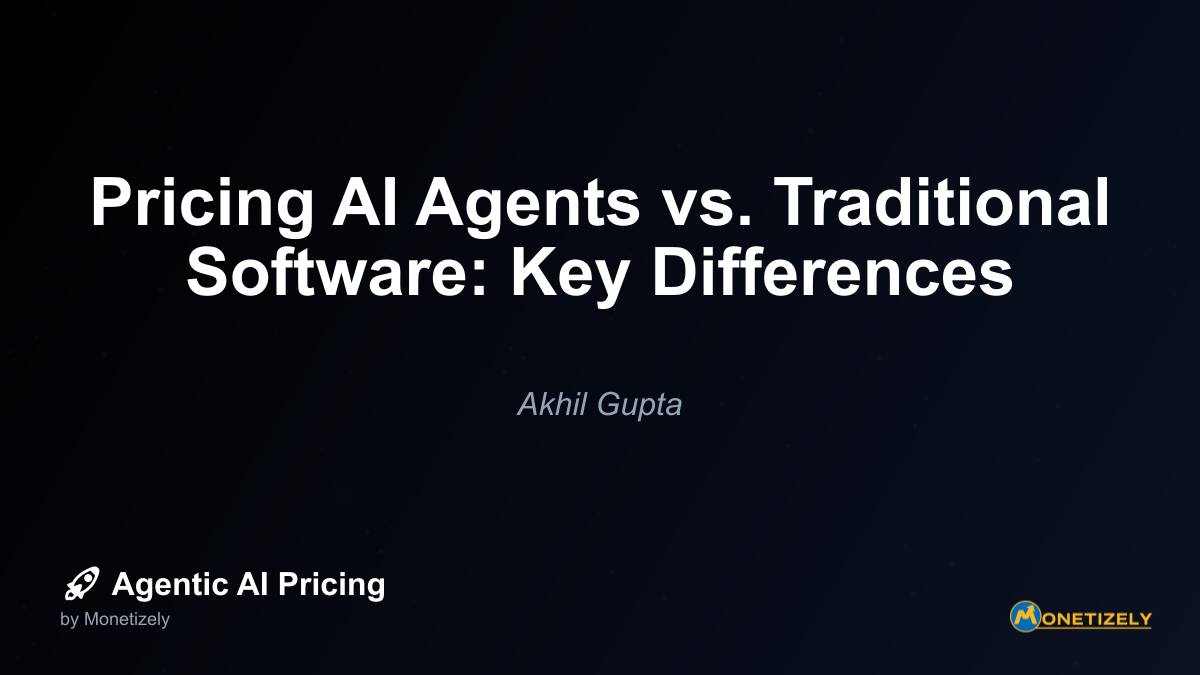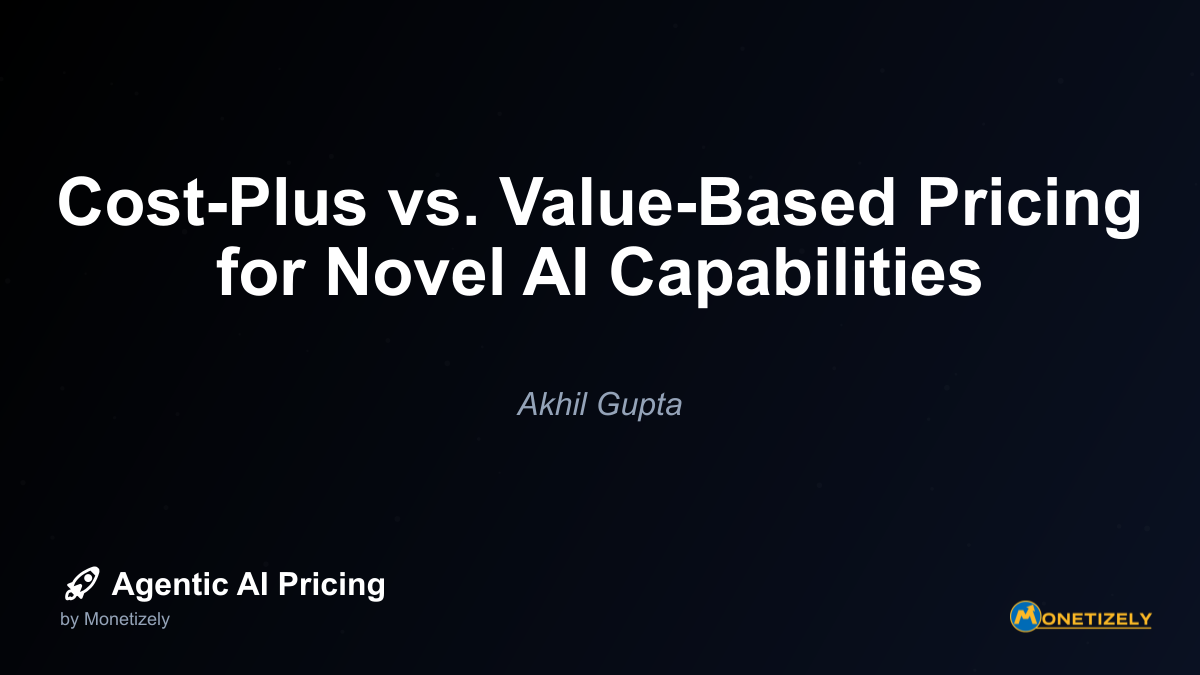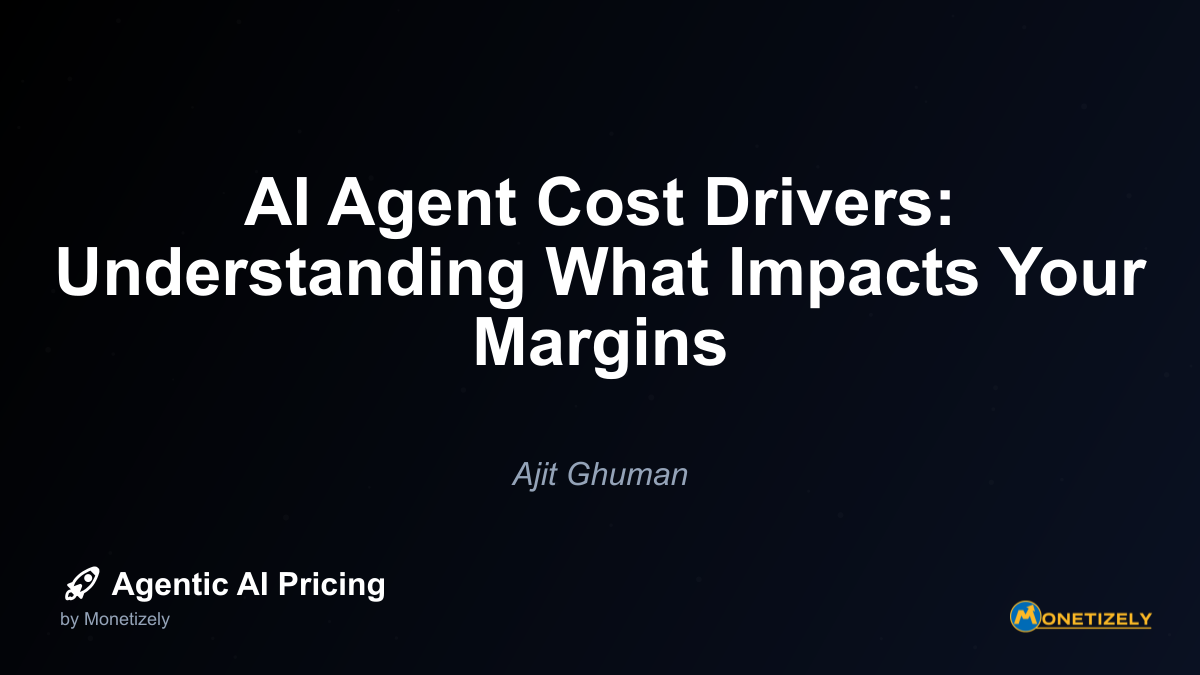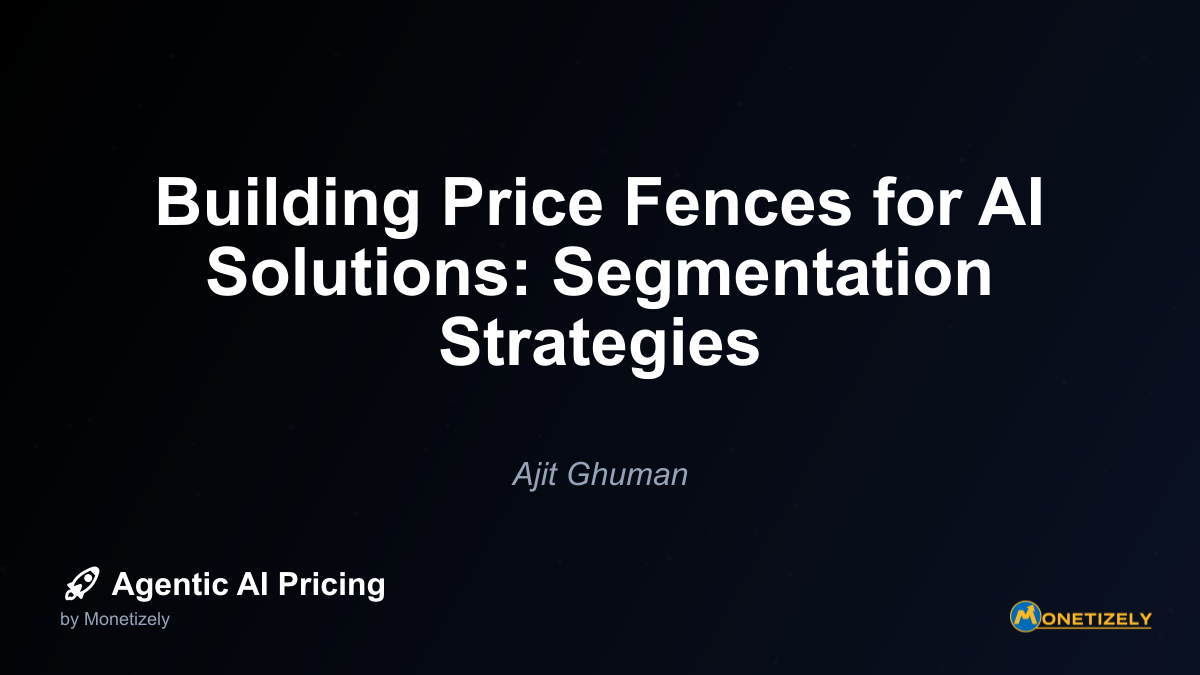· Akhil Gupta · AI Pricing Fundamentals · 5 min read
Pricing AI Agents vs. Traditional Software: Key Differences
AI and SaaS Pricing Masterclass
Learn the art of strategic pricing directly from industry experts. Our comprehensive course provides frameworks and methodologies for optimizing your pricing strategy in the evolving AI landscape. Earn a professional certification that can be imported directly to your LinkedIn profile.

Pricing Model Innovation
Traditional software pricing has converged around several dominant models:
- Perpetual licensing (declining but still present in enterprise contexts)
- Subscription-based SaaS (typically per user/month)
- Freemium models with premium tiers
- Enterprise agreements with volume discounts
AI agents are driving innovation in pricing structures that better align with their unique value delivery mechanisms. Emerging models include:
- Performance-based pricing tied to accuracy or outcomes
- Hybrid models combining baseline subscriptions with usage components
- Token-based pricing for language models
- “Agent-as-a-Service” models with monthly retainers
- Value-share arrangements for high-impact applications
These innovative models better capture the continuous improvement nature of AI agents while aligning vendor and customer incentives. For additional insights on marketplace pricing for AI agents, this comprehensive guide for SaaS executives provides valuable frameworks.
Risk Profiles and Pricing Implications
Traditional Software Risks vs. AI Agent Risks
Traditional software carries well-understood risks: bugs, security vulnerabilities, performance issues, and compatibility problems. Pricing strategies accommodate these risks through warranties, service level agreements, and support tiers.
AI agents introduce entirely new risk dimensions:
- Hallucination risk - Generating plausible but incorrect information
- Alignment risk - Acting in ways that conflict with user intentions
- Bias risk - Perpetuating or amplifying societal biases
- Dependency risk - Creating over-reliance on imperfect systems
- Black box risk - Making decisions without clear explanations
These novel risks significantly impact pricing strategies. Companies must decide whether to:
- Price conservatively to account for potential issues
- Offer risk-sharing mechanisms like outcome guarantees
- Include indemnification provisions in pricing agreements
- Create tiered pricing based on risk tolerance
- Develop specialized insurance or warranty offerings
The most sophisticated AI agent pricing strategies directly address these risks, with premium tiers offering stronger guarantees and protections.
Market Maturity and Pricing Evolution
The Current State of AI Agent Pricing
The AI agent market remains in its early stages, with pricing models still evolving rapidly. Current approaches often borrow heavily from traditional software pricing, sometimes awkwardly fitting new value propositions into familiar containers.
Common patterns in current AI agent pricing include:
- Subscription tiers based on capability levels
- Usage limits (tokens, queries, or transactions)
- Basic user-based pricing inherited from SaaS
- Domain-specific pricing for vertical applications
- Experimental performance-based components
These approaches represent transitional models rather than the mature pricing frameworks that will eventually emerge. For specialized domains like legal, medical, and financial sectors, pricing specialized AI agents requires additional nuance beyond general-purpose frameworks.
Future Pricing Trajectories
As the AI agent market matures, several pricing trajectories are likely to emerge:
Value-based pricing dominance - As measurement methodologies improve, pricing will increasingly tie directly to quantifiable outcomes rather than inputs or usage.
Ecosystem pricing - Multi-agent systems will drive bundled pricing approaches that capture the value of agent interactions rather than individual capabilities.
Risk-adjusted pricing - Sophisticated approaches to quantifying and pricing AI risk will emerge, with premium pricing for high-reliability, high-transparency systems.
Dynamic pricing mechanisms - AI-powered pricing for AI systems, with continuous optimization based on usage patterns, outcomes, and market conditions.
Agent marketplaces - Platform models where specialized agents are priced individually within ecosystems, creating new monetization opportunities for developers.
Organizations that anticipate these trajectories can gain significant competitive advantages by aligning their pricing strategies with emerging value perceptions.
Practical Considerations for Pricing Strategy Development
Transitioning from Traditional to AI-Native Pricing
For organizations with established software products incorporating AI capabilities, transitioning pricing models presents particular challenges. Successful transitions typically follow a phased approach:
Discovery phase - Introduce AI capabilities within existing pricing models to gather usage data and understand value perception.
Hybrid phase - Develop parallel pricing structures that allow customers to choose between traditional and AI-centric models.
Value-alignment phase - Gradually shift toward models that directly capture AI-generated value while maintaining revenue continuity.
Optimization phase - Refine AI-native pricing based on market feedback and performance data.
This measured approach allows organizations to evolve pricing alongside customer understanding and acceptance of AI value propositions.
Communicating Value Effectively
The abstract nature of AI agent capabilities creates unique challenges in communicating value. Effective approaches include:
Concrete outcome quantification - Translating AI capabilities into specific business outcomes with measurable impact.
Comparative ROI frameworks - Demonstrating return on investment compared to traditional alternatives or human-performed equivalents.
Risk reduction narratives - Articulating how AI agents reduce specific business risks and their associated costs.
Capability demonstrations - Showing rather than telling through interactive demonstrations tailored to customer use cases.
Social proof emphasis - Leveraging early adopter testimonials to establish credibility and value perception.
These communication strategies help bridge the gap between complex AI capabilities and tangible business value, supporting premium pricing positions.
Conclusion: The Strategic Imperative of AI-Native Pricing
The fundamental differences between traditional software and AI agents necessitate entirely new approaches to pricing strategy. Organizations that merely transplant conventional software pricing models to AI offerings risk significant value leakage and competitive disadvantage.
Developing AI-native pricing requires:
- Deep understanding of the unique value dimensions AI agents create
- Recognition of the different cost structures and scaling economics
- Appreciation for the novel risk profiles and their mitigation costs
- Awareness of emerging market standards and customer expectations
- Willingness to experiment with innovative pricing approaches
For business leaders navigating this complex landscape, pricing strategy becomes a critical competitive differentiator. Those who successfully align pricing with AI’s unique value creation mechanisms will capture disproportionate market share and establish sustainable advantage.
The transition from traditional software to AI agent pricing represents not merely a tactical adjustment but a strategic reimagining of how technology value is captured and shared. Organizations that master this transition will define the next era of technology monetization.
Co-Founder & COO
Akhil is an Engineering leader with over 16+ years of experience in building, managing and scaling web-scale, high throughput enterprise applications and teams. He has worked with and led technology teams at FabAlley, BuildSupply and Healthians. He is a graduate from Delhi College of Engineering and UC Berkeley certified CTO.
Pricing Strategy Audit
Let our experts analyze your current pricing strategy and identify opportunities for improvement. Our data-driven assessment will help you unlock untapped revenue potential and optimize your AI pricing approach.




